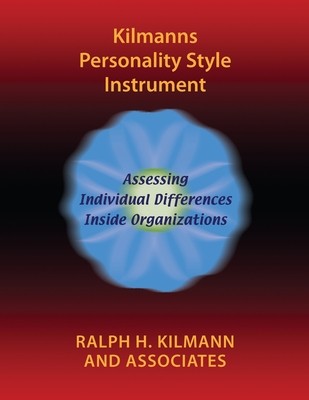
- We will send in 10–14 business days.
- Author: Ralph H Kilmann
- Publisher: Kilmann Diagnostics
- Year: 2012
- Pages: 28
- ISBN-10: 0983274290
- ISBN-13: 9780983274292
- Format: 21.6 x 27.9 x 0.2 cm, softcover
- Language: English
- SAVE -10% with code: EXTRA
Reviews
Description
Based on C.G. Jung's 1921 theory of psychological types, four personality styles are examined in an organizational context: Sensation Thinking (ST), Intuition Thinking (NT), Sensation Feeling (SF), and Intuition Feeling (NF). These four personality styles have vastly different preferences and approaches for defining and solving workplace problems. Kilmanns Personality Style Instrument is a self-report assessment that takes 10 to 15 minutes to complete and another five minutes to graph the results: Individuals and groups discover that they tend to approach problems in either (1) a specialized manner (favoring one style of managing problems while ignoring the other three styles) or (2) a generalist manner (giving due attention to how each of the four styles plays an important role in managing complex problems). In either case, individuals and groups learn why different styles are needed for sensing problems, defining problems, deriving solutions, implementing solutions, and then evaluating results.
EXTRA 10 % discount with code: EXTRA
The promotion ends in 19d.23:09:39
The discount code is valid when purchasing from 10 €. Discounts do not stack.
- Author: Ralph H Kilmann
- Publisher: Kilmann Diagnostics
- Year: 2012
- Pages: 28
- ISBN-10: 0983274290
- ISBN-13: 9780983274292
- Format: 21.6 x 27.9 x 0.2 cm, softcover
- Language: English English
Based on C.G. Jung's 1921 theory of psychological types, four personality styles are examined in an organizational context: Sensation Thinking (ST), Intuition Thinking (NT), Sensation Feeling (SF), and Intuition Feeling (NF). These four personality styles have vastly different preferences and approaches for defining and solving workplace problems. Kilmanns Personality Style Instrument is a self-report assessment that takes 10 to 15 minutes to complete and another five minutes to graph the results: Individuals and groups discover that they tend to approach problems in either (1) a specialized manner (favoring one style of managing problems while ignoring the other three styles) or (2) a generalist manner (giving due attention to how each of the four styles plays an important role in managing complex problems). In either case, individuals and groups learn why different styles are needed for sensing problems, defining problems, deriving solutions, implementing solutions, and then evaluating results.


Reviews